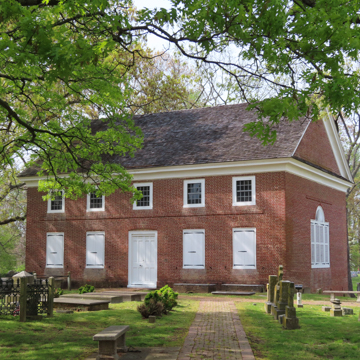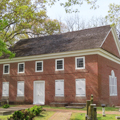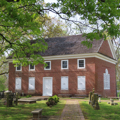The Anglican parish dates back to 1704, when “poor Brother Jenkins at Appoquinimink” was “baited to death by mosquitoes and blood-thirsty gal-nippers,” as a contemporary account described; but the present church was erected during the tenure of Reverend Philip Reading, famous in the Revolutionary War for locking up the facility rather than omit the prayer for the King (1705–1955, Celebrating the 250th Anniversary, 1955). Reading replaced the earlier log church with this five-bay brick box, which closely resembles a dissenters' meeting house. Its rectilinear severity is subtly relieved by variations in the brick-work: segmental arches over first-story windows, stringcourses of differing lengths, bricklaying that ranges from English bond to Flemish bond according to the relative hierarchy of the facades (the back wall is all-English). Some have thought the building must be earlier than the traditional date, given the old-fashioned cove cornice, but a letter in 1772 from Reading back to friends in London shows that he was proud of its up-to-date appearance: “This Church is designed and constructed in a manner that would do credit to a populous city.” Reading called attention to the east window “finished in the Venetian form”; to the “elegant” pulpit and reading desk on the north wall; the “large, handsome gallery” on the south; and the “spacious, convenient pews.” In short, “the inside work of this edifice is much applauded by all who see it, for its elegance in the execution, and for its well-proportioned disposition of its several parts.”
During the revival of Anglicanism under Bishop Alfred Lee, the building was restored in the summer of 1847, its high-backed box pews cut down and rearranged facing east, where the pulpit (reduced in size) was moved. The congregation was meeting in town by 1867 (see LN16), and, subsequently, the building has been open only occasionally, in summertime. A project begun in 1952 by Albert Kruse, who had just finished another restoration (NC12), reversed the 1847 alterations. He removed a termite-damaged exterior vestibule; returned the gallery to its original, smaller size; rebuilt the pulpit in its original position and form (with three levels and sounding board); returned the architrave over the Palladian window to a slender profile; and replaced the window framing. His south door copies the surviving west one, with its tall panels. The altar has been said to be the only pre-Revolutionary one surviving in an American church.
The churchyard, walled in 1913, is memorable for its nineteenth-century tombstones and cast-ironwork and includes the contents of several family graveyards removed here from the countryside. An enormous white oak may be 330 years old.







